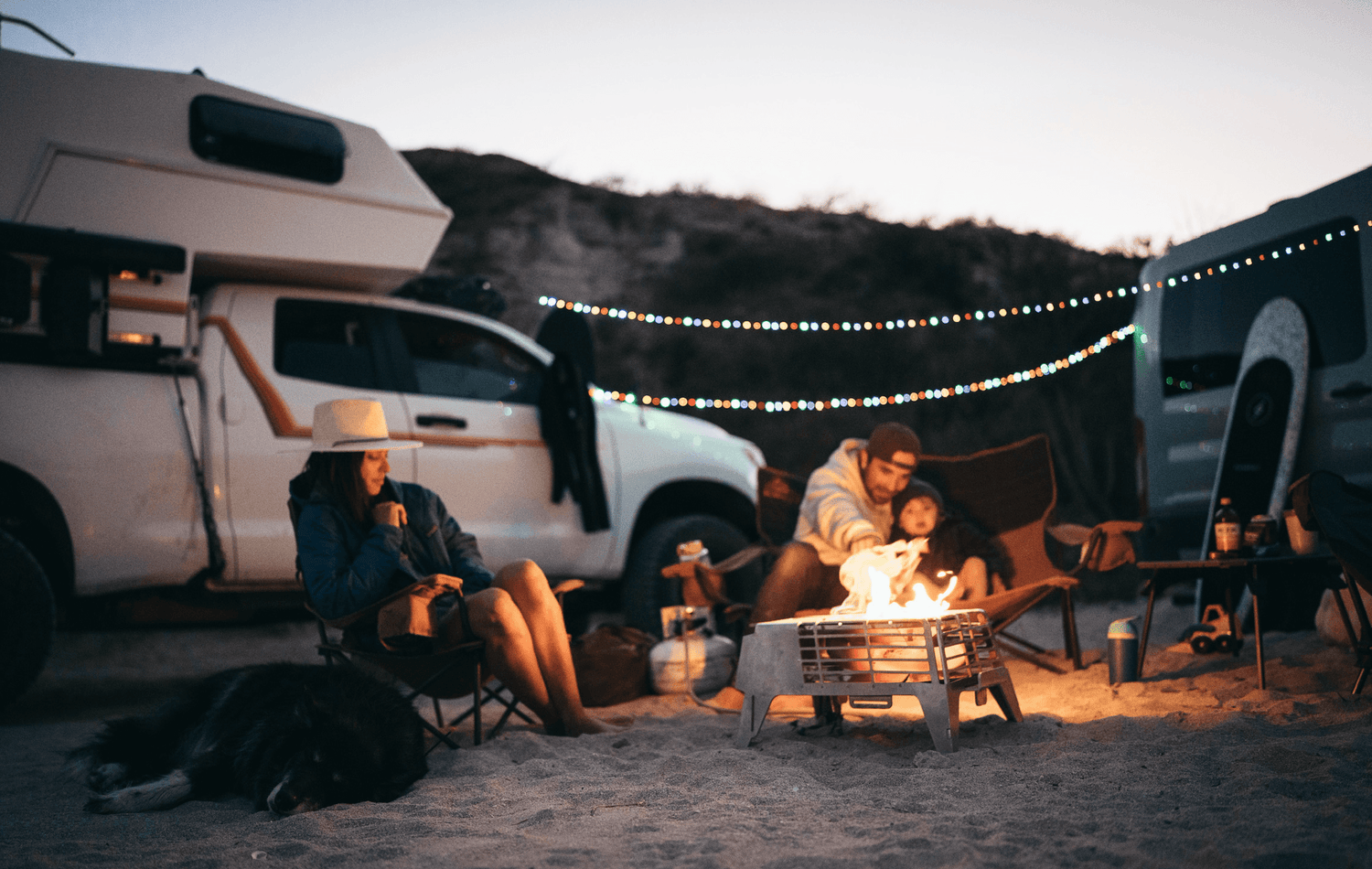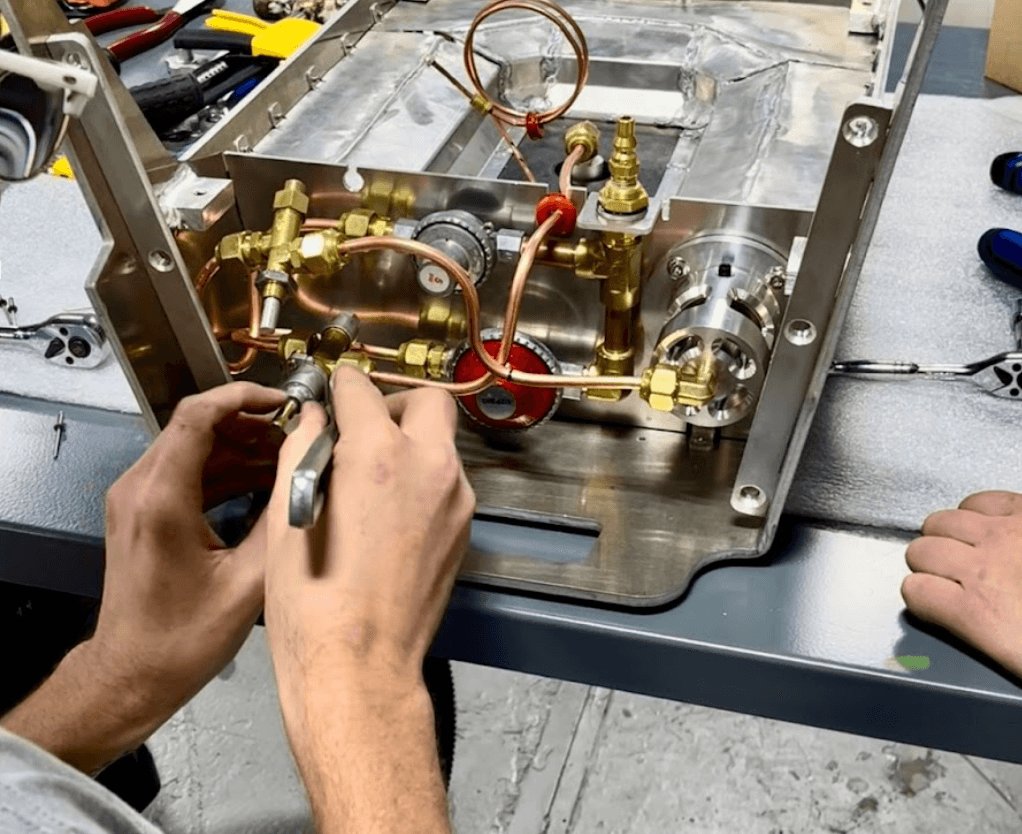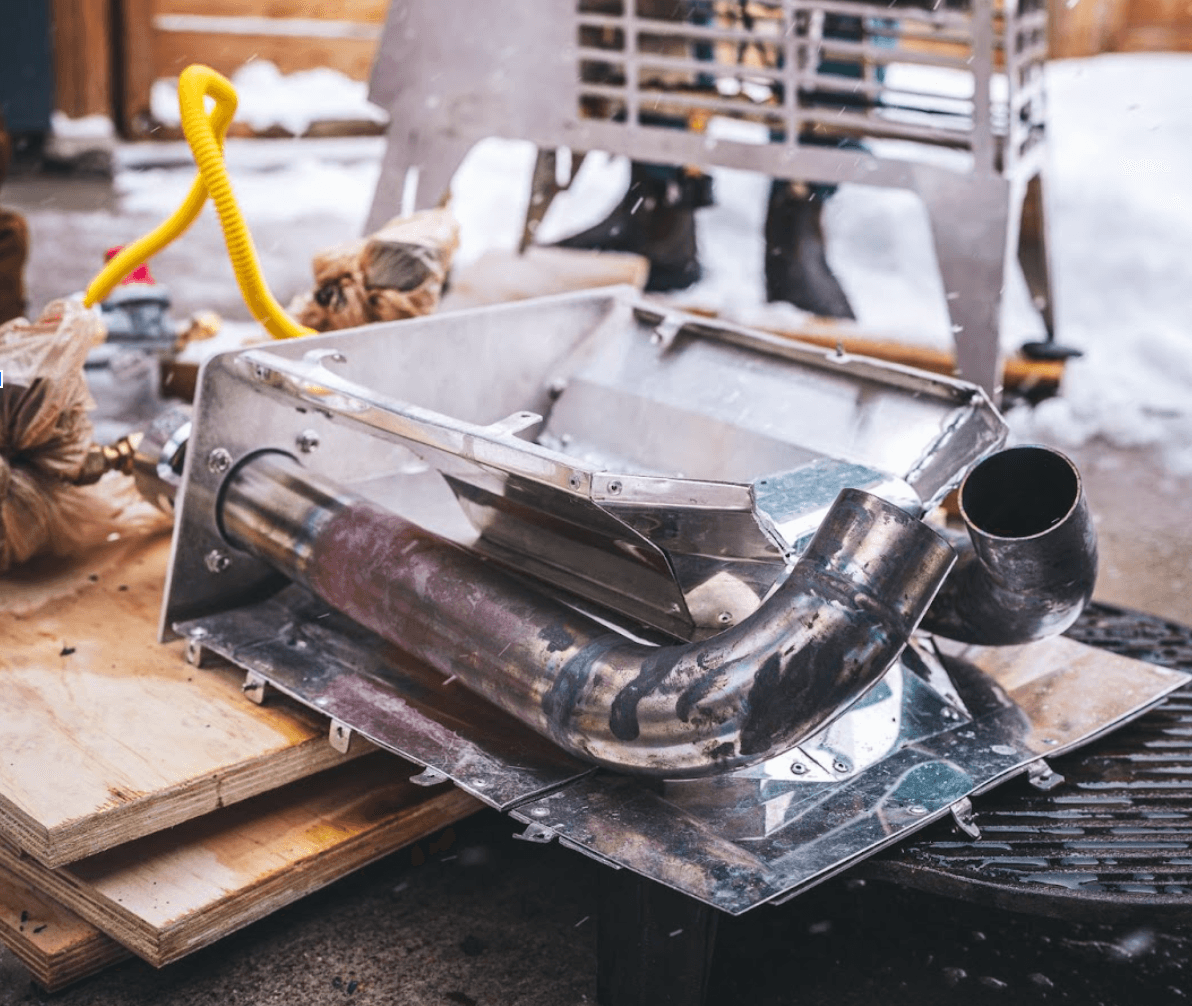Kelly waited a while for us to really take in what we were seeing. Then he said it, and you could hear the big smile in his voice. “This thing’s got a Stargazing Mode.”
Welcome back to the campfire, folks! We’re glad you’re here.
This guy is #1. Employee #1.
Two months ago, we asked you to help us find our first employee. We’re not sure what you did exactly, but whatever it was… THANK YOU!!!
In less than a week, our inbox was flooded with 387 resumés from some truly exceptional manufacturing engineers. We’re excited to announce that Diego Horna is HOWL employee #1. He’s already making huge progress, and we can’t wait to show you what his work’s going to do for your campfire experience.

[Diego running rapid iterations on a new A-Flame wind protection concept.]
The Baja fire pit beatdown 🌵
In the last two months, we’ve done some major testing of the V2 Prototype in our makeshift lab. We’re learning a ton about the nuances of combustion physics and the limits of manufacturing precision, which is great.
But there’s only so much you can learn in lab conditions.
We decided it was time to see if we could actually rely on our now very Frankensteined prototype in the sort of conditions we designed it for. So at the end of December, we took the V2 Prototype on a two-week, 5,000-mile winter surf trip down the Baja Peninsula for a proper beatdown.

A very Griswold moment
It was our fourth night on the road, and we were getting ripped by cold 20 mph winds from the arctic blast that had engulfed all of North America. Before the trip, we’d carefully tuned the proto for optimum performance, but now it was cold, and we just wanted to see if cranking the BTUs would better beat back the weather.
So in full Griswold fashion, Randall monkeyed with the internal adjustments, then looked around as if to say, “Drumroll please.” The thing was really humming and started glowing brighter and brighter. We were laughing at the warmth.
Then all of a sudden, the BarCoal hushed to a whisper.

The once-glowing pipe turned cold and black. We checked the valves, the lines – everything was the way it was supposed to be. We picked up the tank, still nearly full, but noticed a thick frost half way down its sides. We checked the pressure gauge, and almost nothing was coming from the tank.
Wait… if the tank could freeze up in Mexico when it’s 40ºF out, how the hell were we going to make it work in a blizzard back home?
Propane tanks just aren’t supposed to fail like this. We were starting to shiver and get really discouraged. But before you hear what happened next, you need to know what happened on the night before…
Epiphany: a whole new propane fire mode
On night three we sat gathered around the V2 Prototype until it was very late. We had our toes in the sand, listening to the alternate roars of surf and wind. For no reason in particular, we decided to kill the A-Flame, and our eyes began to adjust to the moonless night.
Nearly two years ago, at the beginning of our development process, we’d considered a lot of extreme scenarios where we’d light the BarCoal for warmth, but leave the A-Flame off to conserve fuel. In our minds, it was more of a survival mode for the product. It had never occurred to us that we might actually prefer having heat with no light.
But that night, in the moonless, flameless dark, Kelly sat silent while the rest of us kept chatting. After a few minutes, he spoke. “Guys,” he said. “The stars.”
We looked up, gasped, and fell silent. The heavens were just… well…
Kelly waited a while for us to really take in what we were seeing. Then he said it, and you could hear the big smile in his voice. “This thing’s got a Stargazing Mode.”
Wow. He was right. We all just sat there grinning, looking at the Proto, then at the stars, then at the Proto. We were being warmed beautifully by the BarCoal, with no bright yellow light of a fire to muddy our vision. It was incredible.
We hadn’t set out to replicate the dark coal heat of a dying wood fire. We hadn’t really imagined it as a primary use case. But here it was, a surprise gift. Stargazing Mode is now one of our favorite things about the HOWL Campfire. We cannot wait for you to experience it.

["All on" on the left, vs. the dark heat of Stargazing Mode on the right]
Good news beyond the warmth
In a lot of ways, the V2 Prototype was exactly what we needed for 14 days of camping, drying out wetsuits, and keeping warm at night. There’s very little wood to burn in that desert environment, and during our first week, nighttime temperatures didn’t get much above 40 ºF. The cold, wet wind was constant, and the heat was really necessary.

But beyond the prototype’s warmth, the Baja beatdown highlighted three standout qualities:
1 Portability – Travels like two bundles of wood
We transported the V2 Prototype in Kelly’s 2010 Toyota Tundra Access Cab, loaded up with a custom camper in the bed. Kelly deleted the back seat for his dogs Loki and Raven, which left an obvious spot to strap the HOWL Campfire and its standard 20-lb propane tank.
That’s how it rode over 5,000 miles of interstate, two-laners, dirt roads, rocks, mud, beaches, and dunes. The fire pit and tank were easy to secure, easy to unload, and traveled securely next to the doggos with no issues.

2 Burn Time – Burns like seven bundles of wood
The first tank gave us 4 nights worth of solid 2- to 3-hour burns. That massively exceeded our target 7-hour burn time, which simplified the logistics of tank refills and allowed us to get farther off the beaten path.

3 Durability – Toddlers are pretty metal
The V2 Prototype took on rain, salty ocean air, sand, dirt and a ton of vibrations offroading. Every single part that we were planning to carry forward into production held up perfectly.
We even got a bonus durability test when the toddler on the trip stuffed two handfuls of sand down the BarCoal exhaust. Obviously, the Barcoal was not lit at the time. We shook it out, fired it up, and the BarCoal ran well for the next 10 days. But when we got home and took it apart, there was a TON of sand still in the tube. (You should never light this thing with sand or anything else in it. We’ll do a much better job of shaking it out next time.)

[A pile of 'souvenirs.']
Not everything went swimmingly in Mexico
The whole reason we test is to find weaknesses and fix them. That way they don’t become the customer's problem.
This test trip illuminated three key weaknesses that we still need to fix before we move on to manufacturing:
1 BarCoal Heat Consistency – Sides 1 and 2 rip. Side 3? Meh.
In the current design, BarCoal’s heat tube is bent into a large square. The tube is ripping hot close to the burner, which we call Side 1. Side 2 is just a little cooler, and people sitting here get decent heat. But on Side 3, the temperature really falls off. If it’s cold and windy out, you’ll need to put on a whole extra layer compared to Side 1. Ouch.
We’ll be testing a few BarCoal design changes for three-sided scorchiness. Stay tuned 🤘
2 BarCoal Exhaust Wind Affect – Don’t let your exhaust run naked
In the original V2 Prototype, the BarCoal ran through an exhaust box mounted under the top plate of the device. This component proved to be a heat sink that transferred too much heat into the gas line compartment. For Baja, we just deleted it and punched the exhaust straight through the top plate. This eliminated the heat transfer issue, but it made the system more susceptible to wind. We are now working on a few different shielding concepts.

3 A-Flame Wind Affect – It’s actually too aerodynamic.
On the original V2 Prototype, we had crossbars running over the top of the A-Flame burner that made it uncomfortable to carry. The edges were too sharp, so they’d essentially cheese-grate your leg if you were wearing shorts. Also, the crossbars seemed to be conducting heat into the gas line compartment, similar to the exhaust box issue.
We deleted these crossbars, but that allowed wind to flow uninterrupted across the top of the A-Flame burner, which hurt the performance, fuel efficiency, and strength of the flame in windy conditions. We’re now testing wind barrier concepts that protect the A-Flame without scraping anyone’s legs or cooking the gas lines.
Back to our Griswold moment
So there we were on night four of 14, shivering on the beach. The BarCoal was cold and black, and the tank was frost-coated with almost no pressure.
We knew propane tanks will depressurize if the air around them isn’t warm enough to ‘boil’ the liquid propane into gas. But the boiling point of propane is -44ºF, and our thermometers read 40ºF above zero, so an 84ºF spread. The tank shouldn’t have frozen up like that, and we were baffled, cold, tired, and discouraged.
In his frustration, Randall wove a tapestry of obscenities that as far as we know is still hanging in space over the Sea of Cortez.
We’d hit enough obstacles in these last two years of this project to know that it wasn’t the end of the road. But it was likely to become a very long, tiring, frustrating detour – one bad enough to push the product launch back… yet again.
The warmth of home beckoned and we wanted to cut the trip short. Maybe just head home, rest up, lick our wounds, and from there maybe we could pull our heads out of our asses and start the hard work of figuring it out.
For a while we just sat there by the light of the A-Flame, too cold to think and too frustrated to crawl to our sleeping bags. Eventually somebody reached over and turned the dwindling A-Flame off. And now we sat shivering in the dark.
But then something began to happen. Slowly, steadily, the BarCoal started to hum again. The tube glowed hotter, brighter. The pressure in the propane tank was returning, and it was clear the burn had stabilized. Our shivering was gone.
Kelly looked up at the sky and grinned. We were back in Stargazing Mode.
Over the course of the trip, we kept fiddling with the internal controls, allowing the system to draw more or less fuel. We found that whenever we opened everything up for max fuel, the tank reliably froze and depressurized, causing the BarCoal to fail.
It was a consistent, predictable limit. And luckily, when we returned the internal controls to their as-designed tuning, the issue was gone. So the solution was simple: quit monkeying around and just let the thing run as designed.

What’s next?
Now that we’re back in Denver, we are:
- blowing the device apart to check for wear and tear of all components
- modifying the A-Flame burner to function in strong wind conditions
- modifying the BarCoal system to provide consistently scorching heat from all three sides of the Campfire
- testing the modified BarCoal for wind affect
- reassembling so we can beat it up again out on the road
The V2 Prototype proved to be pretty good in Baja. But pretty good is nowhere close to excellent. Once we make the tweaks needed to be excellent in all conditions, we’ll start ramping up tooling for production.
WHEN CAN YOU BUY IT?
As of today, we are targeting Jun 1, 2023 as the date to ship our first production units to customers.
And since you got this email, you’ll be one of the first to know when pre-orders are available.
Guys, once again, we just want to thank you for joining us through all the ups and downs of this journey. We could not have come this far without your encouragement and stoke. We are so excited to be charging into 2023 with you!
Keep carrying the fire,
– Randall, Kelly, Nicholas, Alex, and Diego
P.S. – For you science types: 🥽
Here’s why the propane tank froze up, and how to fix it if you like camping in extreme cold. Plus a note about the “propane” in Mexico...
So inside your tank, you’ve got liquid propane on the bottom with gaseous propane above that fills the volume. Most of the time, the tank is at the same temperature as the air around it, which is crazy since propane’s boiling point is - 44ºF. What keeps that hotter-than-boiling fuel in its liquid form? Pressure. Propane in a tank that’s 80ºF has a pressure of 128 psi. If we drop the temperature to 0ºF, the pressure is 24 psi, which is still more than enough to run the 5 psi BarCoal.
Of course, as Randall (Clark Griswold?) will tell you, it gets more complicated. When we let propane vapors out of the tank, the pressure drops, and the liquid propane boils into vapor to replace what was released. That gets you back to pressure.
Now boiling is a reaction that releases energy and cools the tank. The faster you pull fuel from the tank, the more the propane has to boil to replace it, and colder the tank gets. As the tank gets colder, the propane boils more slowly.
At some point, you can draw fuel so fast – and make the tank so cold – that the liquid can’t boil fast enough to replace what you’re releasing. At that point, the pressure in the tank drops off and you can’t get the fuel you need. That’s call tank freeze-up, and it’s exactly what happened that night in Baja.
The freeze-up point with a 20 lb tank in normal operating temperatures happens when you release more than 90,000 BTUs of propane per hour.
But when Randall fiddled with the internal adjustments, he didn’t quite have it drawing at that rate. We knew that, which is why we were so surprised.
So there had to be more to the story, and here’s what we've learned since.
As it turns out, a lot of the propane available in Mexico is not pure propane. Instead, it gets cut with Butane. Butane is cheaper, and it burns just fine in a lot of applications. BUT it has a much warmer boiling point than propane, which means it will cause a propane tank to freeze-up at much warmer temperatures, and at much lower draw rates. So the tank freeze-up that almost sent us home was caused by cheap gas.
Under optimum tuning, the V2 Prototype has a draw rate of 62,000 BTUs, with both the BarCoal and A-Flame running simultaneously on high. The math says (and we still have some testing to do here to prove it) that at temperatures above 20ºF, with standard US quality propane, there should be zero loss of performance. However, in extremely cold conditions, or with substandard fuel, it may be necessary to heat up the tank to keep both burners cranking at full power. If you can’t heat the tank, you can just decrease your draw rate like we did, and slip into Stargazing Mode. 🔭




